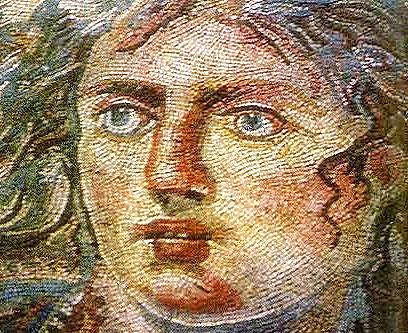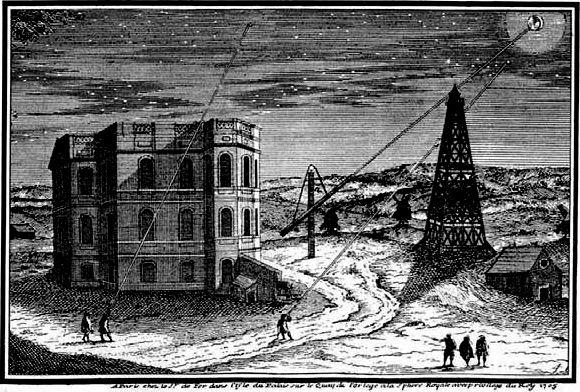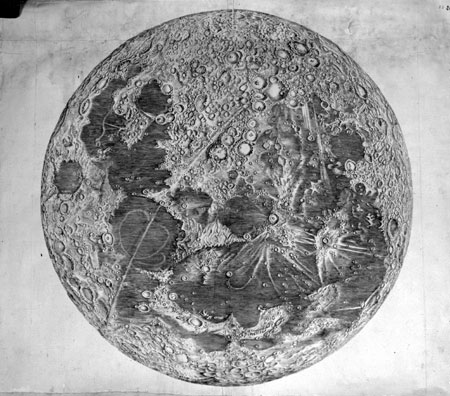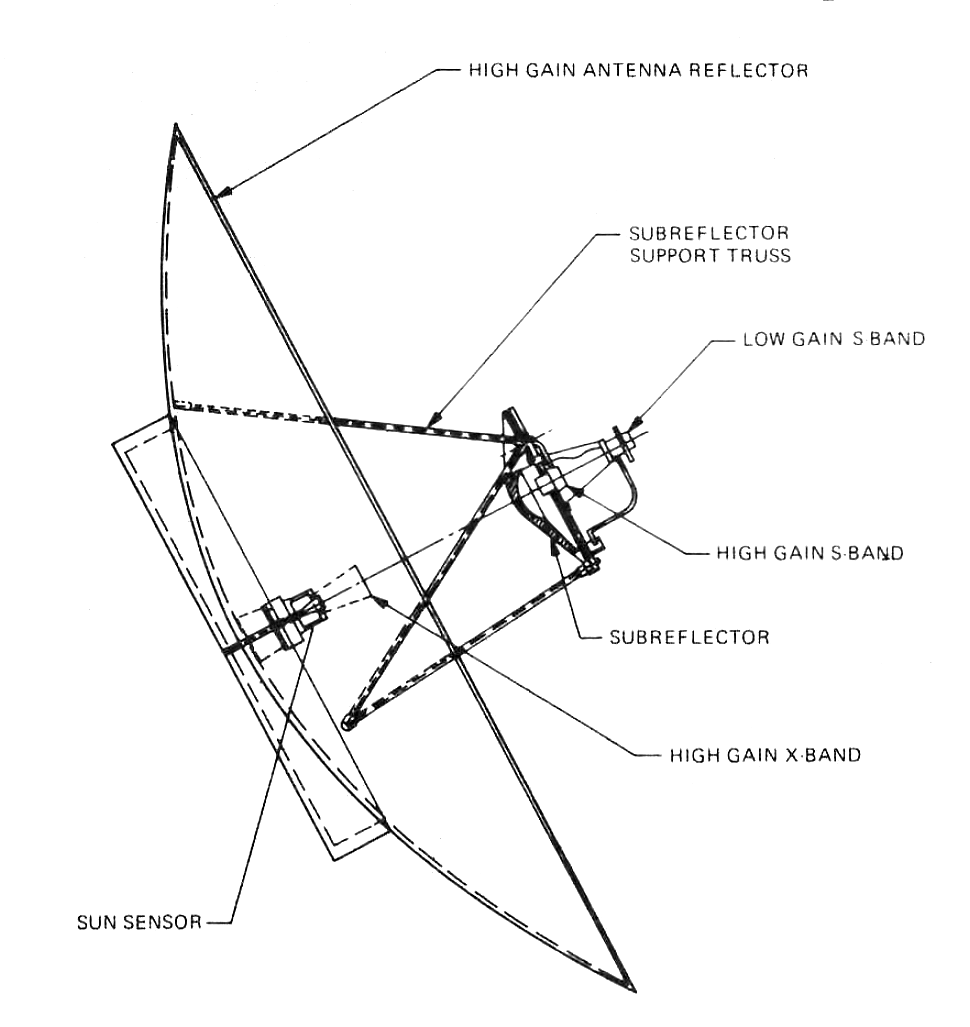|
Tethys (moon)
Tethys (), or Saturn III, is the fifth-largest moon of Saturn, measuring about across. It was discovered by Giovanni Domenico Cassini in 1684, and is named after the titan Tethys of Greek mythology. Tethys has a low density of 0.98 g/cm3, the lowest of all the major moons in the Solar System, indicating that it is made of water ice with just a small fraction of rock. This was confirmed by the spectroscopy of its surface, which identified water ice as the dominant surface material. A further, smaller amount of an unidentified dark material is present as well. The surface of Tethys is very bright, the second-brightest of the moons of Saturn after Enceladus, and neutral in color. Tethys is heavily cratered and cut by a number of large faults and trench-like graben. The largest impact crater, Odysseus, is about 400 km in diameter, whereas the largest graben, Ithaca Chasma, is about 100 km wide and more than 2,000 km long; the two surface features may be re ... [...More Info...] [...Related Items...] OR: [Wikipedia] [Google] [Baidu] |
Tethys (mythology)
In Greek mythology, Tethys (; ) was a Titans, Titan daughter of Uranus (mythology), Uranus and Gaia (mythology), Gaia, a sister and wife of the Titan Oceanus, and the mother of the River gods (Greek mythology), river gods and the Oceanids. Although Tethys had no active role in Greek mythology and no established cults, she was depicted in mosaics decorating baths, pools, and triclinium, triclinia in the Greek East, particularly in Antioch and its suburbs, either alone or with Oceanus. Genealogy Tethys was one of the Titan offspring of Uranus (Sky) and Gaia (Earth). Hesiod lists her Titan siblings as Oceanus, Coeus, Crius, Hyperion (mythology), Hyperion, Iapetus (mythology), Iapetus, Theia, Rhea (mythology), Rhea, Themis, Mnemosyne, Phoebe (Titaness), Phoebe, and Cronus. Tethys married her brother Oceanus, an enormous river encircling the world, and was by him the mother of numerous sons (the River gods (Greek mythology), river gods) and numerous daughters (the Oceanids). Accordi ... [...More Info...] [...Related Items...] OR: [Wikipedia] [Google] [Baidu] |
Odysseus (crater)
Odysseus is the largest crater on Saturn's moon Tethys. It is 445 km across, more than 2/5 of the moon's diameter, and is one of the largest craters in the Solar System. It is situated in the western part of the leading hemisphere of the moon—the latitude and longitude of its center are 32.8°N and 128.9°W, respectively. It is named after the Greek hero Odysseus from Homer's the ''Iliad'' and the ''Odyssey''. Odysseus was discovered by the ''Voyager 2'' spacecraft on 1 September 1981 during its flyby of Saturn. Geology The Odysseus crater is now quite flat for its size of approximately 450 km. More precisely, its floor conforms to Tethys's spherical shape. This is most likely due to the viscous relaxation of the Tethyan icy crust over geologic time. The floor lies approximately 3 km below the mean radius, while its exterior rim is about 5 km above the mean radius—the relief of 6–9 km is not very high for such a large crater. Inside the crater th ... [...More Info...] [...Related Items...] OR: [Wikipedia] [Google] [Baidu] |
Paris Observatory
The Paris Observatory (, ), a research institution of the Paris Sciences et Lettres University, is the foremost astronomical observatory of France, and one of the largest astronomical centres in the world. Its historic building is on the Left Bank of the Seine in central Paris, but most of the staff work on a satellite campus in Meudon, a suburb southwest of Paris. The Paris Observatory was founded in 1667. Construction was completed by the early 1670s and coincided with a major push for increased science, and the founding of the Royal Academy of Sciences. King Louis XIV's minister of finance organized a "scientific powerhouse" to increase understanding of astronomy, maritime navigation, and science in general. Through the centuries the Paris Observatory has continued in support of astronomical activities, and in the 21st century connects multiple sites and organizations, supporting astronomy and science, past and present. Constitution Administratively, it is a '' grand étab ... [...More Info...] [...Related Items...] OR: [Wikipedia] [Google] [Baidu] |
Aerial Telescope
An aerial telescope is a type of very long focal length refracting telescope, built in the second half of the 17th century, that did not use a tube. Instead, the objective was mounted on a pole, tree, tower, building or other structure on a swivel ball-joint. The observer stood on the ground and held the eyepiece, which was connected to the objective by a string or connecting rod. By holding the string tight and maneuvering the eyepiece, the observer could aim the telescope at objects in the sky. The idea for this type of telescope may have originated in the late 17th century with the Dutch mathematician, astronomer and physicist Christiaan Huygens and his brother Constantijn Huygens, Jr., though it is not clear if they actually invented it. Predecessors: very long "tubed" telescopes Telescopes built in the 17th and early 18th century used single element non-achromatic objective lenses that suffered from interfering rainbow halos (chromatic aberration) introduced by the non- ... [...More Info...] [...Related Items...] OR: [Wikipedia] [Google] [Baidu] |
Iapetus (moon)
Iapetus () is the outermost of Moons of Saturn, Saturn's large moons. With an estimated diameter of , it is the third-largest moon of Saturn and the List of natural satellites, eleventh-largest in the Solar System. Named after the Titans, Titan Iapetus, the moon was discovered in 1671 by Giovanni Domenico Cassini. A relatively low-density body made up mostly of ice, Iapetus is home to several distinctive and unusual features, such as a striking difference in coloration between its leading hemisphere, which is dark, and its trailing hemisphere, which is bright, as well as a massive Equatorial ridge on Iapetus, equatorial ridge running three-quarters of the way around the moon. History Discovery Iapetus was discovered by Giovanni Domenico Cassini, an Italian-born French astronomer, in October 1671. This is the first moon that Cassini discovered; the second moon of Saturn to be discovered after Christiaan Huygens spotted Titan (moon), Titan 16 years prior in 1655; and the sixth ... [...More Info...] [...Related Items...] OR: [Wikipedia] [Google] [Baidu] |
Rhea (moon)
Rhea () is the second-largest moon of Saturn and the ninth-largest moon in the Solar System, with a surface area that is comparable to the area of Australia. It is the smallest body in the Solar System for which precise measurements have confirmed a shape consistent with hydrostatic equilibrium. Rhea has a nearly circular orbit around Saturn, but it is also tidally locked, like Saturn's other major moons; that is, it rotates with the same period it revolves (orbits), so one hemisphere always faces towards the planet. The moon itself has a fairly low density, composed of roughly three-quarters ice and only one-quarter rock. The surface of Rhea is heavily cratered, with distinct leading and trailing hemispheres. Like the moon Dione, it has high-albedo ice cliffs that appear as bright wispy streaks visible from space. The surface temperature varies between −174 °C and −220 °C. Rhea was discovered in 1672 by Giovanni Domenico Cassini. Since then, it has been visi ... [...More Info...] [...Related Items...] OR: [Wikipedia] [Google] [Baidu] |
Dione (moon)
Dione (), also designated Saturn IV, is the fourth-largest moon of Saturn. With a mean diameter of 1,123 km and a density of about 1.48 g/cm3, Dione is composed of an icy mantle and crust overlying a silicate rocky core, with rock and water ice roughly equal in mass. Its trailing hemisphere is marked by large cliffs and scarps called chasmata; the trailing hemisphere is also significantly darker compared to the leading hemisphere. The moon was discovered by Italian astronomer Giovanni Domenico Cassini in 1684 and is named after the Titaness Dione in Greek mythology. Dione was first imaged up-close by the ''Voyager 1'' space probe in 1980. Later, the '' Cassini'' spacecraft made multiple flybys of Dione throughout the 2000s and 2010s as part of its campaign to explore the Saturn system. Name Giovanni Domenico Cassini named the four moons he discovered ( Tethys, Dione, Rhea, and Iapetus) '' Sidera Lodoicea'' ("the stars of Louis") to honor king Louis XIV. Cassini ... [...More Info...] [...Related Items...] OR: [Wikipedia] [Google] [Baidu] |
Giovanni Cassini
Giovanni Domenico Cassini (8 June 1625 – 14 September 1712) was an Italian-French mathematician, astronomer, astrologer and engineer. Cassini was born in Perinaldo, near Imperia, at that time in the County of Nice, part of the Savoyard state. He discovered four satellites of Saturn (planet), Saturn and noted the division of its rings, later named the Cassini Division. Cassini was also the first of his family to begin work on the project of creating a topographic map of France. In addition, he also created the first scientific map of the Moon. The Cassini–Huygens, ''Cassini'' space probe, launched in 1997, was named after him and became the fourth to visit Saturn and the first to orbit it. Life Time in Italy Cassini was the son of Jacopo Cassini, a Tuscan, and Giulia Crovesi. In 1648 Cassini accepted a position at the observatory at :it:Panzano, Castelfranco Emilia, Panzano (Castelfranco Emilia), near Bologna, to work with Marquis Cornelio Malvasia, a rich amateur astron ... [...More Info...] [...Related Items...] OR: [Wikipedia] [Google] [Baidu] |
Moons Of Saturn
The moons of Saturn are numerous and diverse, ranging from tiny moonlets only tens of meters across to the enormous Titan (moon), Titan, which is larger than the planet Mercury (planet), Mercury. There are 274 natural satellite, moons with confirmed orbits, the most of any planet in the Solar System. This number does not include the many thousands of moonlets embedded within Rings of Saturn, Saturn's dense rings, nor hundreds of possible kilometer-sized distant moons that have been observed on single occasions. Three moons are particularly notable. Titan is the second-List of natural satellites, largest moon in the Solar System (after Jupiter's Ganymede (moon), Ganymede), with a Atmosphere of Titan#Composition, nitrogen-rich Earth-like Atmosphere of Titan, atmosphere and a landscape featuring river networks and lakes of Titan, hydrocarbon lakes. Enceladus emits jets of ice from its south-polar region and is covered in a deep layer of snow. Iapetus (moon), Iapetus has contrasting ... [...More Info...] [...Related Items...] OR: [Wikipedia] [Google] [Baidu] |
Voyager 2
''Voyager 2'' is a space probe launched by NASA on August 20, 1977, as a part of the Voyager program. It was launched on a trajectory towards the gas giants (Jupiter and Saturn) and enabled further encounters with the ice giants (Uranus and Neptune). The only spacecraft to have visited either of the ice giant planets, it was the List of artificial objects leaving the Solar System, third of five spacecraft to achieve Solar escape velocity, which allowed it to leave the Solar System#Farthest regions, Solar System. Launched 16 days before its twin ''Voyager 1'', the primary mission of the spacecraft was to study the outer planets and its extended mission is to study interstellar space beyond the Sun's heliosphere. ''Voyager 2'' successfully fulfilled its primary mission of visiting the Exploration of Jupiter, Jovian system in 1979, the Exploration of Saturn, Saturnian system in 1981, Exploration of Uranus, Uranian system in 1986, and the Exploration of Neptune, Neptunian system ... [...More Info...] [...Related Items...] OR: [Wikipedia] [Google] [Baidu] |
Voyager 1
''Voyager 1'' is a space probe launched by NASA on September 5, 1977, as part of the Voyager program to study the outer Solar System and the interstellar medium, interstellar space beyond the Sun's heliosphere. It was launched 16 days after its twin, ''Voyager 2''. It communicates through the NASA Deep Space Network (DSN) to receive routine commands and to transmit data to Earth. Real-time distance and velocity data are provided by NASA and Jet Propulsion Laboratory, JPL. At a distance of from Earth , it is the most distant human-made object from Earth. The probe made Flyby (spaceflight), flybys of Jupiter, Saturn, and Saturn's largest Natural satellite, moon, Titan (moon), Titan. NASA had a choice of either conducting a Pluto or Titan flyby. Exploration of Titan took priority because it was known to have a substantial atmosphere. ''Voyager 1'' studied the weather, magnetic fields, and rings of the two gas giants and was the first probe to provide detailed images of their ... [...More Info...] [...Related Items...] OR: [Wikipedia] [Google] [Baidu] |
Pioneer 11
''Pioneer 11'' (also known as ''Pioneer G'') is a NASA robotic space probe launched on April 5, 1973, to study the asteroid belt, the environment around Jupiter and Saturn, the solar wind, and cosmic rays. It was the first probe to Exploration of Saturn, encounter Saturn, the second to fly through the Asteroid belt#Exploration, asteroid belt, and the second to fly by Jupiter. Later, ''Pioneer 11'' became the List of artificial objects leaving the Solar System, second of five artificial objects to achieve an escape velocity allowing it to Solar System#Farthest regions, leave the Solar System. Due to power constraints and the vast distance to the probe, the last routine contact with the spacecraft was on September 30, 1995, and the last good engineering data was received on November 24, 1995. Mission background History Approved in February 1969, ''Pioneer 11'' and its twin probe, ''Pioneer 10'', were the first to be designed for exploring the outer Solar System. Yielding to multip ... [...More Info...] [...Related Items...] OR: [Wikipedia] [Google] [Baidu] |












